 |
|
http://commons.wikimedia.org/wiki/File:Nothofagus_cunninghamii_140-8584.jpg |
 |
| http://de.wikipedia.org/wiki/Benutzer:Michael_w |
Translate this page:
Summary
Physical Characteristics

 Nothofagus cunninghamii is an evergreen Tree growing to 55 m (180ft 5in) at a fast rate.
Nothofagus cunninghamii is an evergreen Tree growing to 55 m (180ft 5in) at a fast rate.
See above for USDA hardiness. It is hardy to UK zone 9. It is in leaf all year. The species is monoecious (individual flowers are either male or female, but both sexes can be found on the same plant) and is pollinated by Wind.
Suitable for: light (sandy), medium (loamy) and heavy (clay) soils and prefers well-drained soil. Suitable pH: mildly acid and neutral soils. It cannot grow in the shade. It prefers moist soil.
UK Hardiness Map
US Hardiness Map
Synonyms
Fagus cunninghamii.
Plant Habitats
Woodland Garden Canopy;
Edible Uses
References More on Edible Uses
Medicinal Uses
Plants For A Future can not take any responsibility for any adverse effects from the use of plants. Always seek advice from a professional before using a plant medicinally.
None known
References More on Medicinal Uses
The Bookshop: Edible Plant Books
Our Latest books on Perennial Plants For Food Forests and Permaculture Gardens in paperback or digital formats.

Edible Tropical Plants
Food Forest Plants for Hotter Conditions: 250+ Plants For Tropical Food Forests & Permaculture Gardens.
More

Edible Temperate Plants
Plants for Your Food Forest: 500 Plants for Temperate Food Forests & Permaculture Gardens.
More

More Books
PFAF have eight books available in paperback and digital formats. Browse the shop for more information.
Shop Now
Other Uses
Wood
Wood - strong, tough, close grained, light, polishes well. Used for joinery, cogs of wheels, furniture etc[154, 156, 167].
Special Uses
References More on Other Uses
Cultivation details
Prefers an open well-drained loamy soil in a sunny position[1, 200]. Succeeds on most soils but dislikes calcareous soils[1, 200]. Prefers a pH between 5 and 7 but dislikes acid peats[200]. Plants are hardy to at least -7°c in Australian gardens[157], though this cannot be translated directly to British gardens due to our cooler summers and longer colder and wetter winters. They only succeed outdoors in the milder areas of Britain[1]. Young plants at Crarae in western Scotland in 1992 appear to be very hardy and robust[191]. Plants in the wild vary in size from shrubs to very big trees according to rainfall and altitude[11]. Trees have poor wind resistance in Britain, probably because they grow so fast[11]. Another report says that this species is slow growing in cultivation[157]. Trees up to 4 metres tall can be successfully established, though the optimum size for transplanting is about 30 - 80cm. The roots are very sensitive to desiccation and extreme care should be taken when transplanting them[200]. Another report says that the tree transplants badly[154]. Plants in this genus are notably resistant to honey fungus[200].
References Carbon Farming Information and Carbon Sequestration Information
Temperature Converter
Type a value in the Celsius field to convert the value to Fahrenheit:
Fahrenheit:
The PFAF Bookshop
Plants For A Future have a number of books available in paperback and digital form. Book titles include Edible Plants, Edible Perennials, Edible Trees,Edible Shrubs, Woodland Gardening, and Temperate Food Forest Plants. Our new book is Food Forest Plants For Hotter Conditions (Tropical and Sub-Tropical).
Shop Now
Plant Propagation
The seed is best sown as soon as it is ripe in a cool greenhouse or cold frame. Spring-sown seed requires 2 - 3 months stratification at 1 - 5°c[200]. When they are large enough to handle, prick the seedlings out into individual pots and grow them on in a lightly shaded position in the cold frame for at least their first winter. Plant them out into their permanent positions in late spring or early summer, after the last expected frosts. The seed must not be allowed to dry out according to one report[80] whilst another says that the seed can be stored dry at 2°c for long periods[200]. Cuttings of half-ripe wood, 6 - 10cm with a heel, July/August in a frame[78]. Layering.
Other Names
If available other names are mentioned here
Native Range
AUSTRALASIA: Australia (Tasmania, Victoria (south))
Weed Potential
Right plant wrong place. We are currently updating this section.
Please note that a plant may be invasive in one area but may not in your area so it's worth checking.
Conservation Status
IUCN Red List of Threatened Plants Status :

Growth: S = slow M = medium F = fast. Soil: L = light (sandy) M = medium H = heavy (clay). pH: A = acid N = neutral B = basic (alkaline). Shade: F = full shade S = semi-shade N = no shade. Moisture: D = dry M = Moist We = wet Wa = water.
Now available:
Food Forest Plants for Mediterranean Conditions
350+ Perennial Plants For Mediterranean and Drier Food Forests and Permaculture Gardens.
[Paperback and eBook]
This is the third in Plants For A Future's series of plant guides for food forests tailored to
specific climate zones. Following volumes on temperate and tropical ecosystems, this book focuses
on species suited to Mediterranean conditions—regions with hot, dry summers and cool, wet winters,
often facing the added challenge of climate change.
Read More
Expert comment
Author
Hook.&Oerst.
Botanical References
11154200
Links / References
For a list of references used on this page please go here
Readers comment